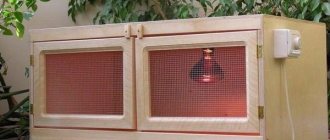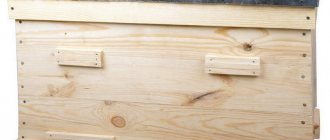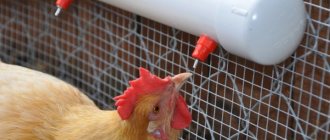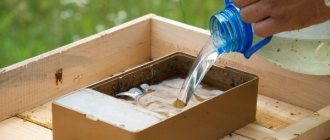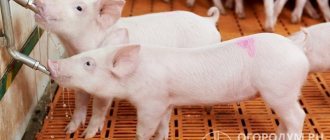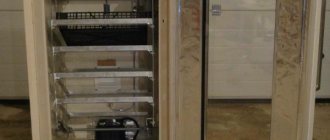When maintaining an apiary, beekeepers need to pump out honey, which is done using a honey extractor.
There are several ways to make a honey extractor with your own hands from available materials. This will help you save significantly on the purchase of expensive equipment. If you have only one hive in your apiary, you can get honey without a honey extractor by consuming it directly from the frame by breaking off the honeycombs. When keeping several bee colonies, a honey extractor is required to ensure high-quality pumping of honey.
This device is a kind of centrifuge equipped with a rotating drum and a stationary tank. Inside the structure there are special cassettes that rotate around their axis, into which frames are placed. As the drum handle rotates, honey begins to flow out of the honeycomb. At the same time, the frames remain intact, so they can be reused.
Types of honey extractors
The type of design will depend on the technical specifications. Depending on how the cassettes are arranged, the devices are divided into two groups.
According to the principle of operation, honey extractors are divided into two types:
- Chordial - frames are inserted into cassettes located along the chords of the main tank circumference. It is clear that you cannot insert more than 4 frames into such a design. Therefore, this type of apparatus is common in private small apiaries;
- Radial - cassettes are located in a circle at the radii of the main tank. The larger the circumference, the more cassettes the structure can accommodate. This arrangement, in addition to the quantitative advantage, has a number of advantages. That is why the radial honey extractor is gradually replacing the chordial one and has even been put into industrial production. The electric drive allows you to pump out honey from a huge number of frames in a short time and without physical effort.
Important! Although honey is pumped out in a radial honey extractor from both sides, honey may remain in some places. In this case, the frame should be laid a second time. If the frame is new, after stripping the frame, it is necessary to tie it with wire to protect it from possible breakage.
Radial
In them, the cassettes are located along the radial perimeter. Thanks to this design, the integrity of the honeycomb is preserved as much as possible, and a lot of honey can be pumped out in one go.
Chordial
Here the cassettes are located on the chords of the circle. In this case, you can install no more than four cassettes. Typically, when using a chordial honey extractor, the risk of damage to honeycombs is higher. In turn, chordial devices can be divided into:
- negotiable. They have hinges on the axes, on which the cassettes are then installed. Thanks to this, the drum can be rotated manually in one direction or the other;
- non-negotiable. In this case, honey is pumped out from one side of the honeycomb, and then they are turned over and the other side is emptied;
- reversible. They work on the same principle as reverse ones, only the rotation is automatic, not manual.
Note! When choosing a material for manufacturing, be sure to take into account its tendency to oxidize. The lower this indicator is, the longer the device will last and the better the quality of honey.
Other options for creating a honey extractor
There are many design options. Let's look at a few more examples of what a homemade design can be.
Wooden
Let’s say right away that it is very important here what kind of wood will be used for the work. Wet, resinous wood is definitely not worth taking. What you need for work:
- planed boards 20 mm;
- aluminum plates 30x40x20 mm;
- wooden slats 10x40 mm;
- bars 26x26 and 30x50 mm.
It is important to make the legs high enough to install a 10-liter bucket under the drain.
The boards are processed with a plane so that their thickness is no more than 20 mm. For the sidewalls, it is better to use one solid board, also pre-processed with a plane. All elements of the body must be sheathed with 20 mm boards, the width of which is 190 mm. The length of the boards should be longer than what is needed, since they should be sanded after fastening. It is also important to fasten the boards so that the grain runs crosswise.
The lower sections of elements A and B (see drawing) are sheathed with 10x40 mm slats. At the bottom of part B, a 20 mm hole is made for pumping out honey. Then a rubber seal is inserted into it, and a wooden plug of the appropriate size is selected.
Important! To make the structure more stable, the legs are constructed from 30x50 mm bars. The height can be any. For greater stability, they can be fixed at a slight angle, and crossbars made of 50 mm wide bars can be installed between them.
Made of aluminum
An aluminum honey extractor is made in almost the same way as from a washing machine. You can use any suitable container for the drum - for example:
- barrel;
- pan, etc.
Even a plastic barrel can serve as a body. It is only important that the plastic is of sufficient quality. This honey extractor does not need a stand - it can be placed on the table, and a bucket for honey can be placed underneath.
Advantages of a radial honey extractor
If we compare the two types of structures, it becomes obvious that the chordial device cannot compete with the radial one in any respect:
- The productivity of a radial honey extractor, even with a manual drive, is at least 2 times greater than that of a chordial one;
- On a radial honey extractor, the frames are pumped almost dry, which is impossible to achieve on a device with a chordal design;
- The main force during operation of the device is directed along the plane of the honeycomb, and not across, as in chordial-type devices. This increases the safety of the cells during operation, there are almost no breakdowns;
- On devices designed for 45 honeycombs, it is possible to pump out honey from the caps of the honeycombs, which have accumulated during the working process. This greatly increases efficiency, since doing such work manually is troublesome and time-consuming;
- In chordal structures, the honeycombs come into contact with the elements of the honey extractor, which can cause the development of putrefactive processes; in radial devices, this possibility is excluded;
- The frames are not glued to the drum during the pumping process, which means they are easy to remove from the device.
Important! In radial honey extractors there is no need to turn over the honeycombs, since pumping occurs from both sides at once. This also provides additional time savings.
Characteristics
- The main force in the structure is directed to the upper bar; it acts along the plane of the honeycomb. There is no strong lateral pressure that can damage the “cells” of the honeycombs.
- In the absence of rotary cassettes, only the drum rotates - all other elements are static.
- The honeycombs do not come into contact with equipment parts - a guarantee that they will not be infected with dangerous parasites.
- Simultaneous pumping from both sides of the frame is a powerful effect of centrifugal force.
- The main parts are not subject to constant friction and practically do not wear out.
Having a drawing of a radial honey extractor, it is easy to make the device. But this option is suitable for a small apiary. For a large farm, it is better to purchase a factory model.
Features of pumping out a radial honey extractor
All beekeepers know that a radial honey extractor can be made with your own hands, using the instructions and recommendations. Before you start making it, you need to familiarize yourself with the features of pumping in this way:
- first you need to remove the railing;
- the frames need to be installed in the cutouts so that the beam can rest on top;
- After filling the honey extractor, the lid will close and the operation phase will begin thanks to the manual drive. Electrically driven designs are considered very reliable;
- At first, the movements of the device are not very fast, they gradually speed up;
- during rotation, honey flies out from different sides;
- speed increases to maximum;
- Next, you need to stop the honey extractor and open the lid to remove the frames with honeycombs;
- If the frames contain a huge amount of honey, they can be pumped again.
Usage
The electric honey extractor is equipped with a toggle switch (control of revolutions), a timer (setting the required time), and revolutions (adjusting the speed of rotation of the cassettes). When you make a unit with an electric drive yourself, it is much easier to work with it.
Before use, the manual gearbox is removed from the structure. The shaft is inserted into the bracket with bearings. The drive is fixed using bolts. Then install the pulley and secure it with nuts. Instead of a drive, a drive is attached, the belt is put on a pulley.
Design and principle of operation of homemade products
To understand how a honey extractor works, it is enough to familiarize yourself with its design. Different materials are used to manufacture the equipment, but the principle of operation remains identical for all models: a centrifugal force is created in the drum, under the influence of which the sweet product is pushed out of the honeycomb. Honey scatters along the walls of the barrel, and then gradually flows down. At the bottom of the device there is a hole through which the product enters the container.
Regardless of the internal design, the honey extractor consists of:
- reservoir for collecting honey;
- internal elements (drive and cassettes located inside the tank).
There are mechanical and automated models. In the first case, a manual or foot drive is used, and in the second, an electric motor.
Depending on the arrangement of frames, radial and chordial honey extractors are distinguished.
Drive installation
When collecting honey, it is recommended to place the device on a wooden cross so that there is a container under the tap for draining the product. And if there is only one beekeeper working in the apiary, then while he is unsealing the honeycombs, the honey extractor is idle; When pumping out honey on a chordial honey extractor, not only the drum is in motion, but also the mechanism for turning the cassettes, the cassettes themselves, levers and the drive. After this, put on the belt cable and tighten the spring. They can be screwed in parallel.
Using a round file, drill a recess of 0.12 cm in the wheel, then use a triangular tool to give it the final wedge-shaped shape. However, not every farmer can afford to buy a rather expensive unit, but manufacturing it, as it turns out, is not very difficult. Torque, instead of human hands, is provided by an electric motor powered by rechargeable batteries or from a volt network. Operation of the honey extractor The pulley wheels are tightened with a belt using a spring. The braking of the device is smooth. A lighter model is constructed from plywood, fastened with nails or glue. The device allows you to adjust the speed and time of pumping out honey. Rotating, it separates the honey from the honeycomb frames. Review of honey extractor with electric drive ABB-100, apiary
Electric drive for honey extractor
To equip the structure with an electric drive for 24 frames, you need to use a DC motor. Thanks to it, the speed of voltage changes is controlled. The radial honey extractor is equipped with an electric drive so that it is electric. To do this, you need to use a gearbox, a power supply system, and a motor. It is better to take a car engine, as it is more reliable and powerful.
If desired, you can use a gear motor designed for cleaning glass. It has two speed modes, so you don't need a reverse regulator. To start the electric drive, the drum is deployed
It is important that the belt does not slip. You can design it yourself using diagrams and drawings
Honey extractor from a washing machine
Knowing about the process of assembling a honey extractor with your own hands from a washing machine, the beekeeper will spend 1-2 days on its manufacture. For this you will need:
- two washing tubs;
- container for draining honey;
- several screws;
- metal rods;
- pulley;
- belt;
- bearing;
- pipe.
Beekeepers use simple and complex diagrams to create a device; sometimes a honey extractor is made according to drawings.
The simplest and most accessible method is the following: the bottom is cut out in one of the prepared tanks, while no changes are made to the design of the second. Next, the first tank is inserted into the second, after which the metal rods are welded on one side to the bearing, and on the other to the inside of the lower tank in three different places.
A metal pipe is inserted into the bearing, cut to the required length and crimped to the diameter of the bearing. It is attached to the tank using self-tapping screws.
A pulley is screwed to the top of the pipe, and a handle is attached to the bottom. The first and second are connected to each other by a belt. For ease of use, you can install a small tap with a valve at the bottom of the structure through which the collected honey will flow.
Cassette
A cassette frame is installed in the cassettes, standard dimensions: 435x300 mm. If you use a purchased frame, it will have an even smaller diameter.
Sequence of work:
- Fold a rectangle from corners 550 and 520 mm long, 1 mm thick. For reliability, it is better to secure the structure by welding, but it can also be tightened with bolts.
- To stretch the wire mesh into the subframe, make small holes around the perimeter. Using stainless steel wire, stretch it through the holes to create a mesh. In total, you need to make two such grids.
- Make two channels from stainless steel angles 40 mm wide and 1 mm thick.
- Attach homemade mesh between the channels. Weld a strip of steel to one of the ends of the cassette.
- Attach two metal brackets from the edge of the cassette to the channel - top and bottom. Later the structure will be connected to the rotor.
The cassettes are ready. Next, we’ll look at how to prepare the washing machine tank.
Rebuilding the washing tank
All holes at the bottom of the tank must be insulated. To do this, cut out patches from a metal sheet to fit the holes and secure them using a welding machine. To check the tightness, pour water into the structure.
Since all the holes are blocked, you need to make an additional hole yourself to pump out honey. Using a drill, drill it into the wall, right near the bottom of the washing machine tub. You can close the edges with a rubber ring, or you can weld a tap that can be conveniently closed if necessary.
If you decide to leave a simple hole, then you will have to attach a metal plate to cover it. It is attached with a bolt. When you need to close, turn the plate to block the flow.
Preparing the crossbar
For the crossbar, take a metal strip 4 mm thick. The length depends on the diameter of the tank. Use a drill to make holes around the edges so you can install an M10 bolt. Additionally, make two holes closer to the middle of the crossbar, as shown in the figure.
Using a soldering iron, heat the plate and bend its edges at a right angle.
Now mark the installation location on the tank. To do this, install the crossbar strictly in the center, and use a marker to mark the locations for the holes on the tank. Use a drill to make holes in the marked places and secure the crossbar with bolts.
Manufacturing of the rotor bar
Take a strip of steel 15-20 mm wide and 4 mm thick. You need to make a hole along the edges of the plank.
Now you need to secure the bar. To do this, make a shaft. Take a stud and thread it. Drill a hole in the center of the crossbar attached to the tank and install a pin. Place the bevel gear on top of the stud and secure it with a nut. Attach the rotor crossbar from below and secure with a locknut.
It remains to prepare one more plank. You will need a metal strip 600x15 mm. Make holes along the edges and bend them. Now use pins to secure the holes of the rotor bars together with the frame brackets. The movable structure is ready. Thanks to the rotor design, the frames can be turned over on one side or the other. This allows you to extract honey from the combs and completely dry the frames.
DIY stand design for honey extractor
Be sure to make a stable stand under the tank so that you can then place a container for collecting honey. It can be made from a metal rod. Twist the ring from the rod so that it is slightly larger than the lower diameter of the tank. The ends are secured by welding.
Make some legs from the same rod and install the structure. For stability, you can weld metal strips to the legs.
A homemade stand is made from the following materials:
- 16 mm reinforcement.
- 8 mm reinforcement.
- 25 cm strip.
- From KAMAZ or ZIL you can use a continuous rim ring.
You also need to take primer paint, electrodes, welding, a paint brush, and a grinder.
The stand is made as follows:
- The stand requires adjustment of the rim ring; a grinder is used for this.
- The stand must have a base; to do this, you need to mark it into 16 parts along the entire diameter, then cut it with a grinder, so the stand will have the correct circumference.
- Expand the ring so that the stand has the appropriate size for the honey extractor.
- If one part of the circle is missing, you can make it and weld it.
- The stand must have up to three posts; 16 mm reinforcement is used for this. Optimal height up to 70 cm.
- Divide the lower ring exactly into three parts, weld the racks to them, so that the structure is strengthened, you need to weld hard ribs.
- The stand must have special soles on the stands, so it will not sink into the ground.
- The last stage is to paint the stand, most often using a gray primer for metal.
In the figure you can see an example of a stand for a honey extractor
Stand for honey extractor
Thus, it is difficult to make a honey extractor with your own hands; for this you need to use special diagrams and drawings. The main thing in the device is the cassettes and the drive; in addition, you need to take care of the stand, it is responsible for the stability of the structure. You must first calculate everything accurately, select all the necessary materials, and only then can you begin work.
Wood splitter made from a flywheel and motor from a washing machine
Reason is given to man in order to make physical labor easier or to get rid of it altogether. This article is dedicated to a wood splitter, which you can make with your own hands from available materials. Such a wood splitter will cost you much less than a purchased one. The machine is assembled on the basis of an engine from a washing machine, and the necessary power for splitting firewood in a homemade product is accumulated by a flywheel from a GAZ-53 car.
The wood splitter is very simple and easy to use, it can easily cope with splitting even knotty stumps, and if you install a more powerful engine, or just two motors from washing machines, it will split almost any stump. If the homemade product interests you, I suggest studying the project in more detail.
List of materials:
– sheet steel, round timber (to make the working shaft); – profile pipes and sheet steel (for the frame); – engine from a washing machine; – flywheel from GAZ-53 or similar; – belt drive; – “carrot” for a wood splitter; – speed controller, switch, wiring; – bearings with brackets; – bolts, nuts, washers, etc.
List of tools:
– turner services; – drill; – grinder; – plasma cutter; – welding machine; – wrenches, marking tools, etc.
Wood splitter manufacturing process:
Step one. Working axis
First of all, let's make a working axis, or rather a blank for it. It is made from round timber to which two steel plates are welded. Cutting the round timber is not a problem; the most difficult thing will be cutting out these two “washers” from thick sheet steel. The author cut them out with a plasma cutter, and then brought them to life with files and a grinder.
As a result, the workpiece was sent to the turner, and the author received a masterpiece. The shaft has a flange for attaching the flywheel, and there is also a machined place for installing the drive belt from the engine.
Next comes the most tedious part - the flywheel needs to be balanced, otherwise there will be strong vibrations. To balance, the author clearly welds two corners horizontally, edge up, and places the flywheel on them, resting it on the axle. By rolling the flywheel and releasing it, you can see in what position it stops; the heaviest point will always be at the bottom. To lighten the flywheel in the right place, you will need to drill out the metal with a drill. A little diligence, and the author coped with this task; the flywheel turned out to be perfectly balanced.
Step four. Protective cover
During operation, the flywheel accelerates to very high speeds; if something happens, you won’t even have time to think about anything. Be sure to make a protective casing, weld a frame from profile pipes and scald it with thick sheet steel. If thick steel is not available, you can weld partitions onto the frame to strengthen the structure.
Step five. Finishing touches and assembly
Let's make a table top for the machine, here we will need sheet steel. On the tabletop we install a wedge from thick plates, which will split the stumps. The author welded partitions into the wedge just in case.
That's all, now all that's left to do is paint the machine and assemble it. After painting it looks great and will not rust now. The car is ready for testing.
Step six
Tests We start the machine, first set low speeds, it is very important that the flywheel spins up gradually. If this rule is not followed, the belt will slip and quickly fail. Here the author came in handy with a 2 kW speed controller
When the flywheel is brought to operating speed, you can start splitting, everything works fine
Here the author came in handy with a 2 kW speed controller. When the flywheel is brought to operating speed, you can start splitting, everything works fine.
It is important to adhere to safety rules when working; you should absolutely not use gloves or long sleeves! Otherwise, the fabric will easily wrap around the carrot, and your hand will go with it. In the case of a machine wedge, there is a bolt head on the other side of the axle, which you can use a wrench to unscrew the carrot from the stump and continue working. In the case of a machine wedge, there is a bolt head on the other side of the axle, using which you can use a wrench to unscrew the carrot from the stump and continue working
In the case of a machine wedge, there is a bolt head on the other side of the axle, which you can use a wrench to unscrew the carrot from the stump and continue working.
DIY radial honey extractor
You can make a radial unit for pumping out honey yourself. This option is especially attractive for small apiaries, when the purchase of ready-made equipment takes a very long time to pay off or may be completely unprofitable economically.
Manufacturing the unit involves the following steps:
- The tank body is best made of stainless steel. You can take a ready-made container of a suitable size as a basis or make a body from sheet material. If you don’t have a welding machine, you can use rivets and cold welding. Recommended case diameter – from 88 cm, height – 69 cm.
- The bottom of the housing must be concave. If a ready-made container is used as a basis, then its bottom must be cut off and replaced with a homemade one.
- The main part of the internal structure is a cage supported by two crosses. Three circles must be attached to the lower cross: the upper one with a diameter of 77 cm and an internal distance of 6.1 cm. The lower and upper circles must be equipped with metal protrusions for frames.
- A steel rod must be screwed into the cage axis. Place a metal glass with a steel ball in the center of the cross - it serves as a support for the rod.
- Make a drain hole in the lower part of the housing and install a faucet. To assemble the honey extractor, it is better to use stainless steel parts.
- The equipment does not require a very powerful engine. Enough power up to 80-90 W. Be sure to install a protective net through which insects cannot penetrate. To regulate the speed, you need to install a rheostat. The relay can be taken from the washing machine.
To process small volumes of products, you can build a mini-honey extractor. It is good to use a washing machine drum as a basis for it.
To learn how to make a honey extractor with your own hands, watch the following video:
The radial honey extractor has several design features and a number of advantages in comparison with chordial equipment. The radial type unit is considered more modern. You can buy a honey extractor or make it yourself - all materials are available, and the costs will be several times lower.
For large profitable farms, purchasing a functional device with an electric drive is not difficult. However, for a small private apiary, the amount of $1000 is not always realistic if the honey is produced within the limits of the family's needs and the sale of surplus. In this case, as always, the Internet comes to the rescue, where you can find many drawings and detailed guides on how to make a radial honey extractor from improvised means.
The basic principles for the production of such a design are as follows:
- In a metal vat (made of galvanized iron) 69 cm high and 88 cm in diameter, cut off the bottom and attach a concave bottom to it - honey will flow here;
- A cross is attached along the lower circumference, and reinforced on the outside with metal hoops;
- A metal cup with a steel ball is installed in the center of the cross. A steel rod will rest on it, which is screwed into the axis of the cage;
- The cage is the main element of the internal structure, which supports two crosses. On the bottom there are 3 circles into which the sidewalls of the honeycomb frames are attached;
- The diameter of the top circle is 77 cm with an internal distance of 61 mm;
- Metal protrusions are made on the upper and lower circles where frames will be inserted;
- The lower circle should not touch the pumped out honey;
- A hole for the faucet is cut at the bottom of the vat;
- All parts must be made of stainless steel or galvanized iron. If this is not possible, then paint it.
Important! If you are confident in your abilities, then making such a design will not be difficult, you just need to find a detailed drawing. In cases where available materials are not enough, you can purchase a manual honey extractor and equip it with an electric drive.
If necessary, you can convert an old device with a chordal design into a more efficient radial one. At the same time, do not forget about safety precautions when testing the fruits of your creativity - after all, if the mechanism is strongly untwisted, the fragile device may not withstand the load, especially when connecting an electric drive. This is why it is strengthened on the outside with hoops.
Material selection
In addition to the design, types of honey extractors can be made from a wide variety of materials. Suitable for homemade products - wood, stainless steel, aluminum, plywood.
Naturally, taking into account the cylindrical design, many craftsmen with imagination adapt ready-made products for these purposes - washing machines, wooden or plastic barrels. But, at this stage, it is necessary to take into account that each material has its own advantages and disadvantages.
This makes metal and plastic easier to clean from drops of honey. Whereas wood is more environmentally friendly if it has not been impregnated with any resins or chemical compounds.
Tree
Wood should be chosen when there is a wooden barrel intended for drying out alcohol. In this case, you can be sure of its environmental friendliness and the absence of various treatments. A honey extractor made of wood can last quite a long time when stored in appropriate conditions that prevent the wood from drying out or, conversely, swelling.
Wooden
Wood of various species is suitable for making a honey extractor, but does not contain resin. An important condition is the dryness of the material.
The sequence of actions is as follows:
- It is more convenient to make the drum in the shape of an octagon. You will need to install a rotor inside and arrange fastenings for the frames.
- It is better to make the side walls of the structure from one solid board. All material must be leveled so that its thickness is no more than 20 mm. The optimal width of boards for cladding is 190 mm.
- Make a drain hole in the lower part of the front wall. A diameter of 20 mm is sufficient. For the hole, you should prepare a wooden plug with a rubber seal or make a faucet. In the second case, you should use a sealant.
- For the stand, use wooden blocks of at least 30x50 mm. Attach the legs to the bottom at an angle, and for reliability, connect them with crossbars and coat the joints with glue. The height of the legs should be oriented to the height of the container into which the honey will flow.
Aluminum
You can use a tank, large pan or other aluminum container as a body. Make a drain hole in the lower part of the body and install a faucet.
This installation is attractive due to its ease of manufacture - the case is already ready, so all that remains is to install the drive and make fastenings for the frames.
Plywood
Plywood ensures lightweight construction. The material should be of medium thickness - optimally 10 mm. A plywood honey extractor is made similarly to a wooden structure.
The body can be held together using small nails or wood glue. After gluing the side panels, you should use a metal hoop to tighten them - this will increase the strength and reliability of the structure.
The inside of a plywood honey extractor must be treated with wax. It is applied in several layers.
Stainless steel
This honey extractor is manufactured similarly to an aluminum structure. The only difference is the material from which the container should be made.
If you can’t find a ready-made container for the case, you can make it yourself. To do this, you will need sheet stainless steel, which is sold by any specialized store. The best connection option is to use a welding machine. If it is not available, you can connect the edges of the iron with rivets, and ensure the tightness by cold welding or silicone sealant - in this case, no special equipment or special skills are required.
Made of plastic
Plastic is one of the simplest and cheapest options. It is optimal to find a plastic barrel. If the container is cracked or there are other damages, they can be repaired using a soldering iron. For this, a strip or piece of plastic of a suitable size is enough. The soldering iron melts the material, and after cooling it is securely fixed.
For repairs, you need to use plastic of the same type as on the damaged segment. The best option is to cut a piece or strip of material from the same container.
In the lower part of the body, according to the standard algorithm, a drain hole is made, the faucet is fixed and treated with sealant.
Rules for making a radial honey extractor with your own hands
The homemade device is distinguished by its quality. It is not difficult to design it yourself. The radial honey extractor is a metal vat with a height of 700 mm and a diameter of 890 mm. Galvanized iron is used for manufacturing; its bottom is concave and has a cone-shaped shape. Hoops can be attached to the outside; a metal cage should be mounted inside, which presses the cross at the bottom.
Ways to combat dangerous bee pests
Radial honey extractor rotor
The device is difficult to construct with your own hands. It must be equipped with a metal vat, galvanized iron will do, the bottom must be concave, cone-shaped:
- The outer part of the vat must be equipped with special hoops.
- The metal cage is mounted inside the vat, please note that it should fit tightly to the cross, which is located at the bottom.
- Then a glass is installed, which has a steel ball, so the steel rods will hold.
- The rod must be screwed into the cell axis, for the manufacture of which a water pipe is used.
- To prevent honey from flowing along the axis, you need to install a 30 mm iron tube on the top of the vat.
The drawing will help you design a high-quality and reliable device.
Drawing “Radial type honey extractor with 12 frames”
Making a cage for a radial honey extractor
The device necessarily contains crosses - in the upper and lower parts. On top - this will be a reliable support for the circle; it must be equipped with a special frame mount. At the bottom, the crosspieces will help support up to three circles; they contain the side parts of honeycombs and frames. The vat should hold about one hundred kilograms of honey. Please note that the cage should be located high so that it does not reach the bottom, so the honey that is pumped out will not be affected.
Honey will be supplied using special taps. It’s easy to make a radial honey extractor with your own hands in a horizontal position. There are a lot of positive reviews about homemade radial honey extractors; they are especially valued in industrial apiaries.
Please note that it is difficult to build an electric drive; for this you need to select a drawing and strictly follow it.
Operating principle
The operation of a honey extractor is based on the action of centrifugal force. The honeycombs printed using a special knife are placed in cassettes. They hold the frames while the drum rotates. During this rotation, honey, under the influence of centrifugal force, is thrown onto the walls of the honey extractor and flows from them to the bottom, falling through a special hole into the substituted container. The technology, as you can see, is very simple, but effective, so having such a design at your disposal will not be superfluous for any beekeeper, even a beginner.
The principle of operation of a homemade honey extractor
For a metal tank you need to prepare a special aluminum alloy. A homemade honey extractor will have a tank at the bottom, the shape must be conical, and there must be a tap in the tank with which the honey will be drained.
The stages of operation of a homemade honey extractor include:
- Printing honey using a special fork.
- Placement of product into cassettes.
- The handle with which the device is equipped rotates, thus increasing the speed.
- Due to centrifugal force, honey from the honeycomb ends up in the tank.
- After draining, the product ends up at the bottom.
- The bottom should be equipped with a special tap, which, when opened, helps the honey flow out.
Device Features
The radial honey extractor is designed in such a way that the cassettes are located along the radii of a circle . So, in order to pump out honey, you need to remove the bar from both sides, and then place the frames in the cutouts of the lower circles. This must be done so that the upper beam of the frame rests against two thrust circles - upper and lower.
When the device is filled, you can begin pumping out honey directly: close the lids and set the honey extractor in motion through a manual or electric drive. To achieve the best result, you should start the rotation at low power, and increase it to maximum towards the end of the cycle. At the end of the procedure, the lids are opened and the frames are removed. If there is still honey left in the frames, they need to be processed again.
Electric drive for honey extractor
To equip the structure with an electric drive for 24 frames, you need to use a DC motor. Thanks to it, the speed of voltage changes is controlled. The radial honey extractor is equipped with an electric drive so that it is electric. To do this, you need to use a gearbox, a power supply system, and a motor. It is better to take a car engine, as it is more reliable and powerful.
If desired, you can use a gear motor designed for cleaning glass. It has two speed modes, so you don't need a reverse regulator. To start the electric drive, the drum is deployed. It is important that the belt does not slip. You can design it yourself using diagrams and drawings.
Economical electric drive option
To save money, you need to use a small number of different parts. A metal rod can be welded to the gear to fit the pulley. This will determine the adjustment of rotational speed. Power will come from the car battery. To equip the device for pumping out honey with an electric drive, you can use a transformer. If you have enough experience and skills, you can develop a speed control unit with your own hands.
Chordial equipment
Experienced beekeepers should know that a chordial honey extractor can be converted into a radial one. Thanks to it, you can pump out about forty frames. However, it has disadvantages - it is not capable of pumping out rapeseed honey fully.
Steps for transforming the chordial device:
- to install the drum from the bottom, you need to weld rings made by yourself from eight millimeter wire;
- the ring is made from a profile or corner on top, and grooves are also introduced into which frames with honeycombs can be installed;
- Before using the device, it is important to wash all internal parts, paint them, and anoint them with beeswax.
The resulting equipment has many advantages, the main one of which is that during use, all honeycombs and frames remain intact and unharmed. The design includes a huge drum with a lever. The drum contains a metal sheet (perforated). This design prevents the penetration of foreign substances into the honey. The device also includes a convenient control unit and speed control.
Step-by-step instruction
- We remove the standard drive from the honey extractor.
- In accordance with the diameter of the honey extractor shaft, we drill a large pulley and install it on top of the shaft.
- We attach an M8 pin to the plate of the device, the sleeve of which must first be opened.
- We finish the generator, attach a small pulley to it, drilled to the diameter of the shaft.
- We put the generator on the pin, fasten it tightly, and connect the electrical voltage to 12 volts.
- On the shoulder of the pulley, using a round file, we grind a groove 8 mm deep, and then with a triangular file we bring the groove to the desired condition, making it wedge-shaped.
- We put the belt on the pulleys and apply tension with a spring. By the way, the spring serves not only to tension the belt. Thanks to it, you can loosen the belt by lightly pressing the motor, then remove the belt, put it on with a figure eight, after which the honey extractor will begin to spin in the opposite direction.
- To start, we use a switch with a clock mechanism, connecting to it the ground and the “I” terminal of the engine.
- In order to adjust the speed, connect terminal “Ш” through one section of the resistance block, that is, connect one section - the speed will drop by half.
- These revolutions will be enough to pump out one side of the frame with honey, then you will need to turn the frames over or turn the belt over in a figure eight and pump out the second side of the frame, first turning on the excitation winding directly.
Rework
Honey extractors are often redesigned. The fact is that due to active use, some parts of this design may wear out.
In this case, the faulty parts must be replaced urgently. You can buy all the necessary spare parts in specialized online stores.
In addition, as a rule, such inventory is calculated for a certain number of frames. However, apiary farming does not stand still and is constantly changing and developing. If the number of frames in your hives has changed, you need to improve and adapt the design of the equipment used for collecting sweet honey products.
There are a lot of tips on the Internet devoted not only to how to repair apiary equipment, but also to how to completely assemble such an effective tool yourself. If you decide to experiment in this way, you won’t have to buy it in a store. This way you can save your financial resources.
Reviews
What reviews are there about radial honey extractors? Both the manufacturers of this tool, intended for use on the territory of the apiary farm, and the apiary owners themselves note their advantages over the chordial design.
To protect the honeycombs from destruction, it is best to use factory frames in your hive. Or carefully choose the material from which you are going to make them yourself.
Unfortunately, the honeycomb is quite fragile, which can lead to damage or deformation during the harvesting process.
The use of the modern tool we are considering for harvesting on the territory of the apiary farm will help prevent this.
By the way, with the help of such a tool you are guaranteed to receive honey that will be absolutely pure and completely ready for further use. How can this be achieved?
The fact is that the drum that rotates in such a mechanism is reliably protected from the ingress of unnecessary and polluting materials. These may include the following elements:
- dead bees;
- pieces of destroyed honeycombs;
- various contaminated particles.
Protection is provided by the design of the cylinder, made of high-quality metal. All contaminants will absolutely not get into the composition of your commercial honey, which will be intended for feeding your family or subsequent sale on the market.
You can pump out honey products not only from honeycombs, but also from special wax caps. It is best to do this at the end of the day or during the midday period.
It is better not to do this procedure in the morning, so as not to disturb the inhabitants of the hive once again. The fact is that the procedure for collecting honey from wax caps is very slow: it must first be melted and only then is it extracted out.
Whatever design of apiary equipment you choose, remember that one of the main criteria here is your convenience in using it. And, of course, you should focus on the features of the hives installed in your apiary.
You shouldn’t chase any fashion trends or rely solely on the advice of your colleagues. When purchasing expensive equipment, you must understand what advantages and disadvantages its use will have for the development of your apiary farm.
DIY honey extractor from a plastic barrel
The most budget option is considered to be a manually operated device made from scrap materials. The easiest way is to make a tank for the device from a plastic barrel. Plastic does not rust and does not absorb odors. In addition, it is perfectly washed off from honey. To make a manual honey extractor with your own hands, you need to prepare:
- rotational element;
- refrigerator shelves;
- barrel;
- boards;
- metal rods.
To make a honey extractor, you need to place a rotational element in the center of the barrel. This could be a drill or a pedal mechanism from a bicycle. Rotary parts from electrical appliances are often used. The refrigerator shelves are attached to this base. This will be a frame cassette. The video will help you in the process.
When the pedals rotate, the cassettes are activated. When rotating, honey from the honeycomb hits the walls of the barrel and flows down. Boards and metal rods are needed to secure the tank.
Device
The device consists of an electric drive and special cassettes that are designed to fit the frame of the Dadan hive. The body and parts are made of stainless steel, and the inner drum is made of steel or metal coated with polymers. All parts are connected end-to-end, which eliminates the possibility of leaks.
The cassettes are placed on the rotor so that they simultaneously unfold under the influence of a spring. They do not stick, which ensures high-quality honey pumping. The rotor rotates using bearings. Under the tank there is a manual removable drive, which includes an electric motor, which is very practical and convenient. Control is carried out using a remote control.
Granovsky's honey extractor has gained popularity among beekeepers due to its ease of use. The possibility of continuous operation for a long time allows for quick pumping of honey in small and large apiaries. The device can be manufactured independently, but in terms of performance it is inferior to its factory counterpart.
It should be noted right away that Granovsky’s apparatus was designed to match the frame designs of Dadan hives. The design consists of a stainless steel body in the shape of a large barrel. Inside there are cassettes for attaching frames. The inner drum is made of ordinary metal with a protective polymer coating. The rotation of the cassettes is carried out by an electric drive.
The cassettes are connected to the rotor by a spring mechanism. Simultaneous rotation during operation prevents the cells from sticking. The rotor rotates on a bearing pair. The manual drive and electric motor are located under the tank. If necessary, the elements can be easily removed and replaced. The electric drive is controlled by the included remote control.
How the device works
Granovsky's honey extractor has a fairly convenient design, which is driven manually. The main convenience lies in the fairly fast and high-quality action, with the help of which it is possible to free the frames as much as possible from honey. Here's how it works:
Granovsky honey extractor for 8 frames
- The manual drive can be located either in the upper or lower part of the tank.
- The drive consists of two main parts - a belt drive and an electric motor.
- The arrangement of cassettes inside is traditional.
- The honey extractor needs at least 15 seconds to reach the preset speed. The final machining process is characterized by smooth braking.
In general, the operating principle of such a device is similar to other honey extractors, but, of course, it has its own characteristics. Video recordings demonstrating the operation of a honey extractor will help you get acquainted with them in detail.
DIY electric honey extractor
If you have a small apiary, then you can get by with a simple manual or mechanical type apparatus. But if you have little time, and the apiary is large, then it is advisable to make a device with an electric drive. Supplement the device with a relay with the ability to switch rotation modes.
Take measurements of parts several times to minimize the possibility of defects.
An affordable option for an electrically driven device is a do-it-yourself honey extractor from a washing machine. All you need to do is add cassettes to the washing machine tank. It is best to use an old baby washing machine.
Cassettes can be made from refrigerator shelves or stainless mesh. Consider where to drain the honey. To properly design the device, you will need drawings of a honey extractor.
What to choose: electric or manual method
The operating principle of the honey extractor involves circular rotation of the drum, which requires a drive. It comes in manual and electric versions. The second option is preferable due to the minimization of human labor. But if the number of bee colonies in the apiary does not exceed 5-7, mechanical rotation can be used.
The electric drive consists of a motor with a power of up to 90 W, which is used as a gearbox for cleaning glass or a car engine.
For ease of operation, the equipment is equipped with a switch. The drive disk includes a rheostat, bracket and rotor.
DIY stand for honey extractor
A stand for this equipment is necessary so that a container for collecting honey can be installed below. Beginning beekeepers use ordinary boxes as a stand, but this is not very convenient. To prevent the device from falling, you can construct a metal stand. To do this, you only need a steel rod (rebar) and a welding machine.
Make a regular ring with a diameter slightly larger than the honey extractor tank. Weld a holder and three legs at the bottom. Choose the height depending on the performance of the machine and the size of the apiary. As you can see, the stand is very simple to make; just decide on the diameter of the barrel and the height of the legs. Many beekeepers use a basket as a stand.
Recommendations for use
- “Manual” device - before work, clean the gears from rust and lubricate them. Be sure to use a guard to prevent grease from falling into the honey.
- Reinforce the homemade model with hoops (the tank is outside) - at high speeds the honey extractor may collapse.
- You should not immediately select the maximum speed - in the first minutes, set low speed for 1 minute, then medium speed for 1 minute, and then increase.
- There is honey left - the cassette does not need to be cleaned, just put it in for a second cycle.
- Use frames with 4-5 lines of tensioned wire (there are 2 wires in a magazine frame).
DIY wooden honey extractor
The entire device, with the exception of the axle and bearings, is made of wood. At the very beginning, cassettes are made according to the size of the hive frames. After this, a wooden barrel is made.
It is better to make a wooden honey extractor from pine or fir boards
Next, the cassettes are attached to the axle. The mechanism with cassettes and axle is installed in a barrel. Don't forget about the handle you will be turning. In this way, a 4-frame honey extractor with reversible cassettes is manufactured. The barrel may be polished inside.
If you do not want to rotate the cassettes yourself, then purchase a drive for a honey extractor. Be sure to buy a relay with the ability to adjust the engine speed. This will prevent the honeycomb from breaking during rotation.
Cassette
Cassettes for honey extractor must be fixed to a rotating axis in a radial or chordal placement method. They are made of mesh with fixing strips around the perimeter. The width of the cassette should correspond to the thickness of the honeycomb, allowing for a small gap to facilitate insertion.
Fixation of cassettes to the axle should be carried out by welding - this is the most reliable method of fixation, providing suitable rigidity.
Assembling a homemade honey extractor
It’s easy to make a honey extractor with your own hands. This process takes about 30–40 minutes. But this is provided that you have made the parts perfectly suitable for each other. First, let's create the subframes. The first step will be to determine the dimensions, because the subframe should easily accommodate a special frame measuring 435x300 mm. When creating a subframe, you need to pay attention to the body frame. Read the drawing carefully to understand how this is all done. We twist a subframe with the required dimensions from a special corner and wire. If you want to make frames of a standard size, you should reduce the dimensions of the subframe.
What should be done?
So:
- We take two strips of steel 1 mm thick and 520 mm long. Then we fold them into a rectangle and connect them together with bolts;
- Using a special drill, we make several small holes around the perimeter of the rectangle, and then stretch the mesh;
- we create a second wire mesh and take two metal strips, and then bend two channels from it;
- between the channels you need to fasten wire mesh and then plug the end by welding a strip of steel;
To avoid deformation of the subframes, one metal strip should be welded to them.
- from one stretcher we attach two brackets to the channel: one from above, the other from below;
- We make the second subframe in the same way as the first, then we put these parts aside.
The next step is to create a container for the honey extractor.
In order for the washing tank to fit perfectly into the base, you need to weld up unnecessary holes and openings. It is worth installing patches from stainless steel sheets, as well as taking an electrode. After all the steps, you need to pour water into the tank. If the tank does not let water through, then you have done everything right.
The next step is to organize a special hole for honey.
We take a drill and a drill and make a hole in the wall of the tank, which is located at the very bottom. The required hole diameter is 25 mm. After this, insert a rubber and tight ring into the hole. Then we take a special steel plate and make a hole in it. Then we make a hole a little higher at the drain hole of the honey extractor. Place the plate on the bolt with washers. Don't forget to bend the plate so that you can move it to the side when you need to open the drain. Next we bend the crossbar and create a few more holes. Holes should be drilled in the center of the crossbar for the central gear.
Well, the last step: we place the crossbar in the middle of the tank hole, divide it in half, and then mark the places where we will make mounting holes for installing the crossbar.
Basic actions:
- take the pin and insert it into the central hole of the crossbar, put the gear on top of it and secure it with a nut;
- We place the rotor on the stud below;
- attach the bar with a special nut;
- we make a straight bar and create holes;
- insert the studs into the subframe brackets and secure the entire mechanism with nuts.
The do-it-yourself honey extractor is almost ready. The drive connection remains. This matter is best left to professionals. Methods of creating a honey extractor using a barrel are also practiced, but this process is much more complicated. How is the cassette stored? It should be stored in a safe and protected place, away from moisture. After use, the cassette is washed.
Sources
- https://pchelka48.ru/pchely/kak-sdelat-medogonku-svoimi-rukami.html
- https://mnogopchel.ru/radialnaya-medogonka/
- https://pasechnyk.ru/pchelovodstvo/izgotovleniya-radialnoj-medogonki.html
- https://bee-master.ru/medogonka-svoimi-rukam-varianty-certezi-materialy/
- https://cosmo-frost.ru/stiralnye-mashiny/samodelki/kak-sdelat-medogonku-iz-stiralnoj-mashiny-svoimi-rukami/
- https://linerecords.ru/medogonka-svoimi-rukami/
- https://ferma.expert/pchely/paseka/radialnaya-medogonka/
- https://pchela-info.ru/pchelovodstvo/radialnoj-medogonki
- https://MedovoeMesto.ru/pchelovodstvo/medogonka-svoimi-rukami.html
- https://mnogo-krolikov.ru/pchelovodstvo/medogonka-svoimi-rukami-chertezhi.html
[collapse]
